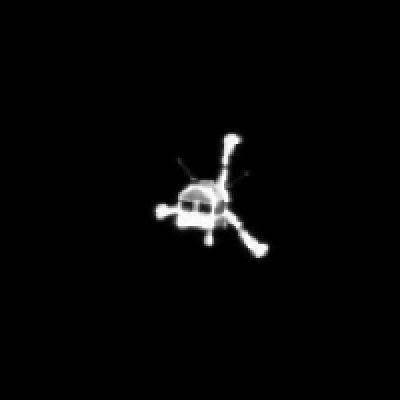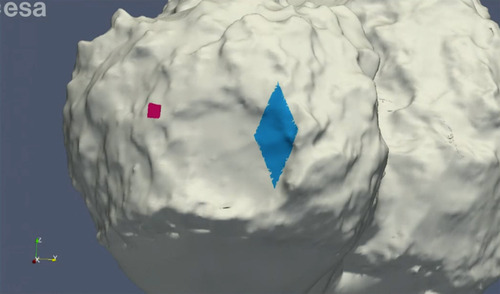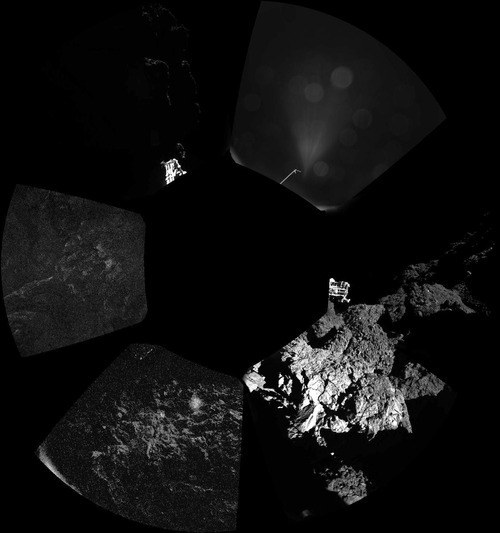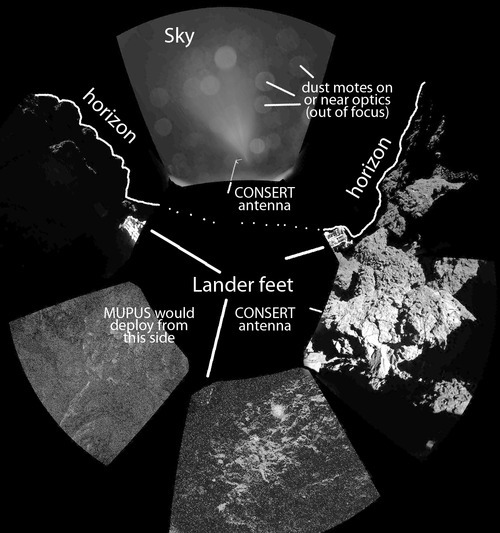The Philae team scrambled all morning to comprehend the initially confusing status of the lander, and the picture is much clearer today. But I can’t talk about clear pictures without showing you the best thing from this afternoon’s press briefing, an animated gif of the descending Philae, captured by the OSIRIS camera:
Philae falling
This animation shows the Philae lander falling away from Rosetta from 10:24 to 14:24 on November 12, 2014, in images taken an hour apart, beginning about two hours after the spacecraft separated at 08:35.
Credit: ESA/Rosetta/MPS for OSIRIS Team MPS/UPD/LAM/IAA/SSO/INTA/UPM/DASP/IDA
I now appreciate why there was so much confusion yesterday. When Philae initially touched down, that triggered the end of its descent sequence and the start of its first block of science activity. Its instruments dutifully performed their measurements and Philae relayed these back to the orbiter — all while Philae was steadily climbing away from the comet at a speed of 38 centimeters per second. At the same time, the internal flywheel was slowly being braked, and that caused Philae to rotate, which was incredibly confusing to a team that thought the spacecraft was stationary on the comet surface.
Here are a few bullet points from the press briefing:
- They do not yet know exactly where Philae landed (more on that below).
- After the initial impact, they rebounded at about 38 centimeters per second — about a third of their 1-meter-per-second impact velocity.
- They saw rotation for about 2 hours after impact, and then rotation stopped (this was while the spacecraft was on its long first bounce).
- They lost the link about 30 minutes after its final touchdown.
- The solar panels are only getting illuminated for 1.5 hours of each 12-hour comet day, which is much, much less than they need in order to keep the lander going after its batteries run out.
- Contrary to earlier reports, the solar panels are not damaged.
Here are few more bullet points on spacecraft activity and status from an ESA update:
- Rosetta is operating nominally; the network systems and overall ground segment to control the mission are nominal
- Last night, Rosetta lost contact with Philae as expected when it orbited below the horizon just after 20:00 CET.
- Contact was re-established this morning at 06:01 UTC / 07:01 CET, and the Philae-Rosetta radio link was initially unstable.
- As Rosetta rose higher above the Philae landing site, the link became very stable and the lander could transmit telemetry (status and housekeeping information) and science data from the surface.
- This morning’s surface link was again lost due to Rosetta’s orbit at about 09:58 UTC / 10:58 CET. Ignacio explains that with the current orbit, Rosetta will have, typically, two Philae communication windows per day.
- The next window opens at 19:27 UTC on the spacecraft and runs through to 23:47 UTC spacecraft time.
Where is the lander on the comet? They don’t know yet. They think they know approximately where it is, thanks to data from the CONSERT instrument. But at least one member of the science team disagrees with this assessment; Holger Sierks thinks it’s about the same distance away from the initial landing site, but in a 10:00 direction rather than a 3:00 direction.
Where did Philae land?
Where did Philae land? Its initial impact point is precisely located within the red square. Its final landing location is not yet known, but CONSERT radar sounder data suggests it is somewhere within the blue diamond.
Credit: ESA
I was initially surprised by this location because it is located prograde (in a rotational sense) from the touchdown site, but after a little further thought I think it makes sense. Here’s the important detail: When Philae was descending, it was in an elliptical orbit around the center of gravity of the comet. That orbit intersected the ground at the intended landing site in such a way that the horizontal component of Philae’s motion was parallel to the orbital motion of the surface at that point, which is another way of saying that the spacecraft landed vertically. (Mission manager Stephan Ulamec described this geometry in a press briefing earlier this week.) So when it bounced off, it bounced off close to vertically in the reference frame of the comet’s surface, and then when it landed it landed a relatively short horizontal distance away from the initial impact site.
They had representatives from all the camera teams — Jean-Pierre Bibring for CIVA, Holger Sierks for OSIRIS, and Stefano Mottola for ROLIS. Mottola showed a ROLIS image captured just 40 meters above the very first impact point. Mottola said the gravels at the initial impact site ranged in size from millimeters to meters in diameter. He pointed at a small boulder in the upper right of the image and mentioned the dust that appeared at its base; he said it is not clear whether the dust is accumulating at the base, or if the rock is being exposed by sublimation.
Comet closeup: ROLIS view of Churyumov-Gerasimenko from 40 meters altitude
The large block at upper right is about 5 meters across; the Philae landing gear intrudes into the upper right corner.
Credit: ESA / Rosetta / Philae / ROLIS / DLR
The star of the morning was ÇIVA. Bibring showed 6 ÇIVA images forming a 360-degree panorama around the lander.
ÇIVA’s view around Philae
Philae has returned the first panoramic image from the surface of a comet. The view, captured by the CIVA-P imaging system, shows a 360° view around the point of final touchdown. Parts of Philae’s landing gear can be seen in some of the frames.
Credit: ESA / Rosetta / Philae / ÇIVA
It’s a little hard to understand what’s going on in this photo, so I’ve stretched the contrast a bit and annotated it, and rotated it so that the horizon is level:
ÇIVA’s view around Philae (annotated)
Credit: ESA / Rosetta / Philae / ÇIVA / annotated by Emily Lakdawalla
So the lander is clearly tilted, with one image showing only sky. The lander has three legs, one in “front” and two to the side rear. The rear right leg is “down” in the image, while the front and rear left legs are up. Taken together with the geometry of the horizon — which curves more than 180 degrees around the lander — and it appears that the lander may actually be in a hole. When I imagined this, I laughed, imagining a comet jet suddenly popping Philae out of the hole like a pea from a straw. Or maybe an exogorth is down there somewhere! But, to get more serious, being in a hole would explain why the solar panels are getting so small an amount of illumination, and may unfortunately doom the lander to the short life dictated by its battery power.
What happens from here? They’re doing as much science as they can without making any mechanical motions. That means no MUPUS surface properties experiments, or use of the APXS, and no deliveries to the gas chromatograph mass spectrometers. There is discussion of possibly using some of these moving devices to attempt to pop the lander up off the comet again, to try to get it into a position where they could recharge the battery. But if they do that, it will be a last-ditch effort.
I have more to report but no more time to report it today. I’ll be at ESOC for one more day, tomorrow, and I’ll try to bring you another update then.




